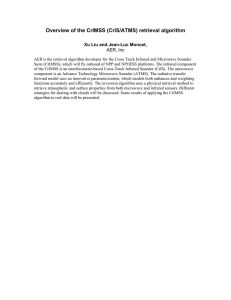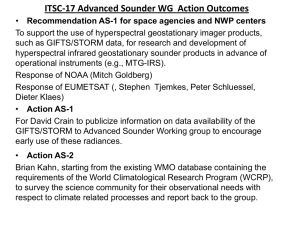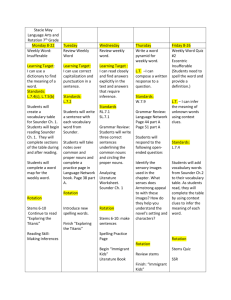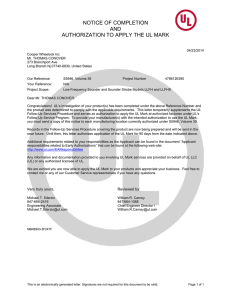Improvement on sounding retrievals from GOES Sounder measurements Jun Li ,Christopher C. Schmidt
advertisement
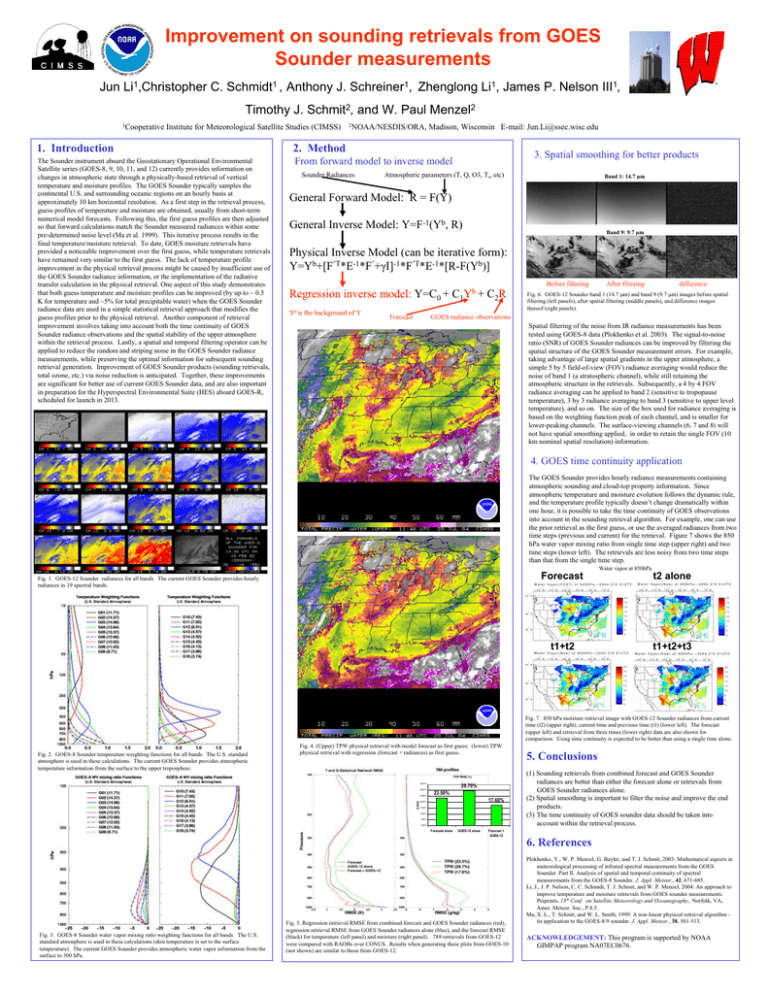
Improvement on sounding retrievals from GOES Sounder measurements Jun Li1,Christopher C. Schmidt1 , Anthony J. Schreiner1, Zhenglong Li1, James P. Nelson III1, Timothy J. Schmit2, and W. Paul Menzel2 1Cooperative Institute for Meteorological Satellite Studies (CIMSS) 2NOAA/NESDIS/ORA, Madison, Wisconsin E-mail: Jun.Li@ssec.wisc.edu 1. Introduction 2. Method The Sounder instrument aboard the Geostationary Operational Environmental Satellite series (GOES-8, 9, 10, 11, and 12) currently provides information on changes in atmospheric state through a physically-based retrieval of vertical temperature and moisture profiles. The GOES Sounder typically samples the continental U.S. and surrounding oceanic regions on an hourly basis at approximately 10 km horizontal resolution. As a first step in the retrieval process, guess profiles of temperature and moisture are obtained, usually from short-term numerical model forecasts. Following this, the first guess profiles are then adjusted so that forward calculations match the Sounder measured radiances within some pre-determined noise level (Ma et al. 1999). This iterative process results in the final temperature/moisture retrieval. To date, GOES moisture retrievals have provided a noticeable improvement over the first guess, while temperature retrievals have remained very similar to the first guess. The lack of temperature profile improvement in the physical retrieval process might be caused by insufficient use of the GOES Sounder radiance information, or the implementation of the radiative transfer calculation in the physical retrieval. One aspect of this study demonstrates that both guess temperature and moisture profiles can be improved (by up to ~ 0.5 K for temperature and ~5% for total precipitable water) when the GOES Sounder radiance data are used in a simple statistical retrieval approach that modifies the guess profiles prior to the physical retrieval. Another component of retrieval improvement involves taking into account both the time continuity of GOES Sounder radiance observations and the spatial stability of the upper atmosphere within the retrieval process. Lastly, a spatial and temporal filtering operator can be applied to reduce the random and striping noise in the GOES Sounder radiance measurements, while preserving the optimal information for subsequent sounding retrieval generation. Improvement of GOES Sounder products (sounding retrievals, total ozone, etc.) via noise reduction is anticipated. Together, these improvements are significant for better use of current GOES Sounder data, and are also important in preparation for the Hyperspectral Environmental Suite (HES) aboard GOES-R, scheduled for launch in 2013. From forward model to inverse model Sounder Radiances 3. Spatial smoothing for better products Atmospheric parameters (T, Q, O3, Ts, etc) Band 1: 14.7 µm General Forward Model: R = F(Y) General Inverse Model: Y=F-1(Yb, R) Band 9: 9.7 µm Physical Inverse Model (can be iterative form): Y=Yb+[F’T*E-1*F’+γI]-1*F’T*E-1*[R-F(Yb)] Regression inverse model: Y=C0 + C1Yb + C2R Yb is the background of Y Forecast Before filtering After filtering difference Fig. 6. GOES-12 Sounder band 1 (14.7 µm) and band 9 (9.7 µm) images before spatial filtering (left panels), after spatial filtering (middle panels), and difference images thereof (right panels). GOES radiance observations Spatial filtering of the noise from IR radiance measurements has been tested using GOES-8 data (Plokhenko et al. 2003). The signal-to-noise ratio (SNR) of GOES Sounder radiances can be improved by filtering the spatial structure of the GOES Sounder measurement errors. For example, taking advantage of large spatial gradients in the upper atmosphere, a simple 5 by 5 field-of-view (FOV) radiance averaging would reduce the noise of band 1 (a stratospheric channel), while still retaining the atmospheric structure in the retrievals. Subsequently, a 4 by 4 FOV radiance averaging can be applied to band 2 (sensitive to tropopause temperature), 3 by 3 radiance averaging to band 3 (sensitive to upper level temperature), and so on. The size of the box used for radiance averaging is based on the weighting function peak of each channel, and is smaller for lower-peaking channels. The surface-viewing channels (6, 7 and 8) will not have spatial smoothing applied, in order to retain the single FOV (10 km nominal spatial resolution) information. 4. GOES time continuity application The GOES Sounder provides hourly radiance measurements containing atmospheric sounding and cloud-top property information. Since atmospheric temperature and moisture evolution follows the dynamic rule, and the temperature profile typically doesn’t change dramatically within one hour, it is possible to take the time continuity of GOES observations into account in the sounding retrieval algorithm. For example, one can use the prior retrieval as the first guess, or use the averaged radiances from two time steps (previous and current) for the retrieval. Figure 7 shows the 850 hPa water vapor mixing ratio from single time step (upper right) and two time steps (lower left). The retrievals are less noisy from two time steps than that from the single time step. Water vapor at 850hPa Fig. 1. GOES-12 Sounder radiances for all bands. The current GOES Sounder provides hourly radiances in 19 spectral bands. Forecast t2 alone t1+t2 t1+t2+t3 Fig. 7. 850 hPa moisture retrieval image with GOES-12 Sounder radiances from current time (t2) (upper right), current time and previous time (t1) (lower left). The forecast (upper left) and retrieval from three times (lower right) data are also shown for comparison. Using time continuity is expected to be better than using a single time alone. Fig. 2. GOES-8 Sounder temperature weighting functions for all bands. The U.S. standard atmosphere is used in these calculations. The current GOES Sounder provides atmospheric temperature information from the surface to the upper troposphere. Fig. 4. (Upper) TPW physical retrieval with model forecast as first guess; (lower) TPW physical retrieval with regression (forecast + radiances) as first guess. TPW RMSE (%) 35.00% 30.00% R M SE 25.00% 29.70% 23.50% 17.60% 20.00% 15.00% 10.00% 5.00% 0.00% Forecast alone GOES-12 alone 5. Conclusions (1) Sounding retrievals from combined forecast and GOES Sounder radiances are better than either the forecast alone or retrievals from GOES Sounder radiances alone. (2) Spatial smoothing is important to filter the noise and improve the end products. (3) The time continuity of GOES sounder data should be taken into account within the retrieval process. Forecast + GOES-12 6. References Fig. 3. GOES-8 Sounder water vapor mixing ratio weighting functions for all bands. The U.S. standard atmosphere is used in these calculations (skin temperature is set to the surface temperature). The current GOES Sounder provides atmospheric water vapor information from the surface to 300 hPa. Fig. 5. Regression retrieval RMSE from combined forecast and GOES Sounder radiances (red), regression retrieval RMSE from GOES Sounder radiances alone (blue), and the forecast RMSE (black) for temperature (left panel) and moisture (right panel). 789 retrievals from GOES-12 were compared with RAOBs over CONUS. Results when generating these plots from GOES-10 (not shown) are similar to those from GOES-12. Plokhenko, Y., W. P. Menzel, G. Bayler, and T. J. Schmit, 2003: Mathematical aspects in meteorological processing of infrared spectral measurements from the GOES Sounder. Part II. Analysis of spatial and temporal continuity of spectral measurements from the GOES-8 Sounder. J. Appl. Meteor., 42, 671-685. Li, J., J. P. Nelson, C. C. Schmidt, T. J. Schmit, and W. P. Menzel, 2004: An approach to improve temperature and moisture retrievals from GOES sounder measurements. Preprints, 13th Conf. on Satellite Meteorology and Oceanography, Norfolk, VA, Amer. Meteor. Soc., P.8.5. Ma, X. L., T. Schmit, and W. L. Smith, 1999: A non-linear physical retrieval algorithm its application to the GOES-8/9 sounder. J. Appl. Meteor., 38, 501-513. ACKNOWLEDGEMENT: This program is supported by NOAA GIMPAP program NA07EC0676.
